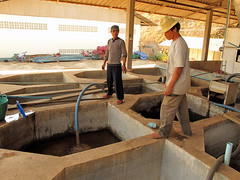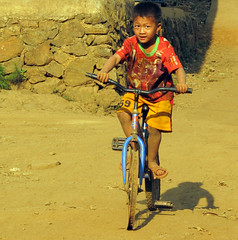We do like our coffee, and the instant coffee so commonly served in Thailand just doesn’t make the grade.
So when a day trip to see the Doi Chaang coffee plant and nearby coffee growing plantations came up, we jumped at the opportunity. A bit of research had shown us that coffee from this region has a Canadian connection, and is considered to provides some of the finest beans in the world.
Nor were we deterred by the fact that it would mean spending a whole day in the back of an open pickup truck ascending steep and winding roads…
 The road leaves the pavement to climb up the side of a ridge covered with cultivated “fields” on steep slopes. At the top of the ridge, our AFECT guide, Edd, pointed out the two distinctive peaks that give the region its name: the shapes of a mother and baby elephant (“doi” is mountain; “chaang” is elephant).
The road leaves the pavement to climb up the side of a ridge covered with cultivated “fields” on steep slopes. At the top of the ridge, our AFECT guide, Edd, pointed out the two distinctive peaks that give the region its name: the shapes of a mother and baby elephant (“doi” is mountain; “chaang” is elephant).
 When we went over the ridge to descend into the Doi Chaang area, the mixed crops changed to dominantly coffee—most under the shade of mixed fruit trees.
When we went over the ridge to descend into the Doi Chaang area, the mixed crops changed to dominantly coffee—most under the shade of mixed fruit trees.
A Royal horticultural project was set up to encourage local people to switch from opium production to coffee. Dozens of coffee plant nurseries along the road, and plantations extending far up the slopes show that the program has had the desired effect.
 The Doi Chaang factory is a collection point for high-quality locally grown coffee. The beans are separated from their red berries in a multi-step process: first by bruising them with a light crusher, then moving them through three different washing vats—each for a full day—to remove the husks. The raw beans are then spread out to dry in the sun.
The Doi Chaang factory is a collection point for high-quality locally grown coffee. The beans are separated from their red berries in a multi-step process: first by bruising them with a light crusher, then moving them through three different washing vats—each for a full day—to remove the husks. The raw beans are then spread out to dry in the sun.
 The dried beans are packed into sacks and warehoused for shipment. The warehouse was about half-full when we visited, and it was mind-boggling to think of how all the sacks could possibly be trucked down the road we had just come up. Edd explained that there is an alternative road, although he said it was pretty bad in some places too.
The dried beans are packed into sacks and warehoused for shipment. The warehouse was about half-full when we visited, and it was mind-boggling to think of how all the sacks could possibly be trucked down the road we had just come up. Edd explained that there is an alternative road, although he said it was pretty bad in some places too.
As a joint venture with a Canadian group, a big part of the production ends up in Canada—primarily Alberta, but also BC and Ontario.
The name hadn’t mean a lot to me until I saw the company brand showing an Akha man with a turban. Then it struck me that we’d enjoyed a delicious latté in Calgary in October—and at the time I’d noted the unique logo!
* * *
 After enjoying a delicious coffee at the plant, we re-boarded our pickup truck and continued on through the village. The return road took us along the side of the valley we’d seen on our way up. This set of 41 Flickr pictures shows some of the highlights. If we decide to return via Thailand in the fall, we will certainly plan to revisit this route.
After enjoying a delicious coffee at the plant, we re-boarded our pickup truck and continued on through the village. The return road took us along the side of the valley we’d seen on our way up. This set of 41 Flickr pictures shows some of the highlights. If we decide to return via Thailand in the fall, we will certainly plan to revisit this route.
